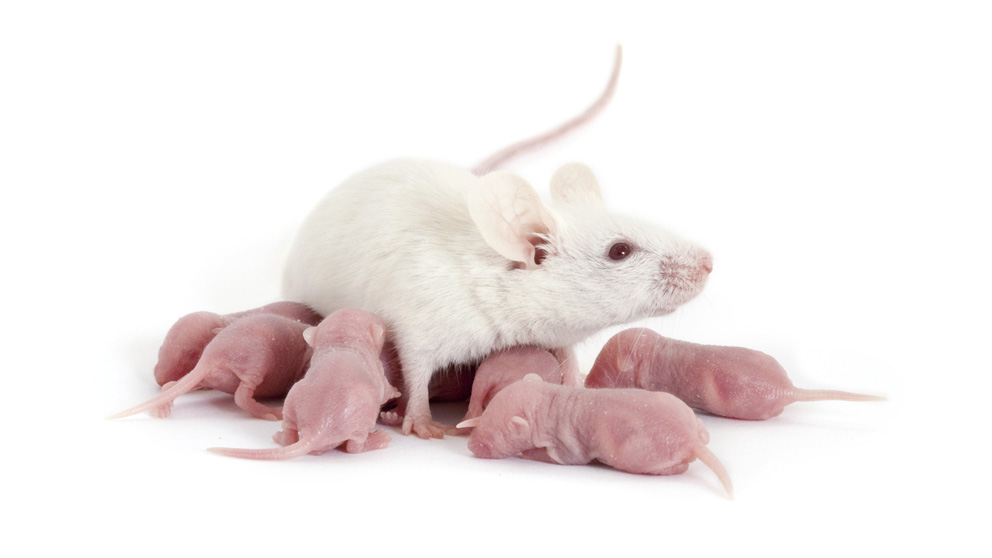
NOD scid gamma (NSG™; 005557)- the most immunodeficient strain of mice- have played a significant role in cancer, diabetes, tissue transplantation, infectious disease and other research into illnesses that affect humans. However, with this high level of immunodeficiency comes an increased susceptibility to pathogens, so disease prevention is crucial to prolonging their lives and thus, utility. “Cleaner” mice and husbandry practices can lead to reduced costs in colony maintenance and on sick mice, as well as increased experimental reproducibility. NSG strains require special practices and preventive measures to maximize their research value, and in this article, we’ll go over important considerations for taking care of them.
1. Housing
As you know, environments are breeding grounds for pathogens, and are a potential source of infection for NSG mice. By reducing the amount of contamination on surfaces that may harbor infectious agents, you minimize the risk of them establishing infection. It’s actually been shown (see Health monitoring, below) that gut commensal microbes can cause pathology in NSG mice, if adequate measures are not taken to ensure a sufficiently clean environment. Even if you are used to working with other immunodeficient strains, keep in mind that barrier practices adequate to maintain nude (002019 and 007850), or even scid (001303 and 001803) mice may not be adequate for NSG.
- Use sterilized microisolator or pressurized individually ventilated (PIV) caging designed to minimize the spread of airborne particles between cages
- Disinfect surfaces (laminar flow hoods, experimental equipment, floors, walls)
- Sterilize tools (forceps, scissors, ear punches, etc.), bedding, and cages
- Change cages weekly to prevent the accumulation of commensal organisms that might infect NSG.
2. Food & Water
As with the environment, food and water can also be sources of contamination. Ask providers about the quality of their products, including where materials used in feed are obtained, and how is it handled. It is possible that they may harbor infectious agents, parasites or disease vectors (insects or other pests). For this reason, all food, water and bedding that enter a mouse room should be autoclaved or sterilized in some way.
At JAX, we acidify the drinking water to pH 2.5-3.0 before autoclaving to control Pseudomonas species. Although many investigators maintain NSG mice on antibiotic-treated water as a prophylactic measure against infection, we don’t, nor do we recommend doing so, as it encourages the development of drug resistance
3. PPE
Personnel handling the mice are potential reservoirs and vectors for the spread of infection. As such, personal protective equipment (PPE) should be worn at all times to cover skin and other potential routes of infection. At JAX, everyone entering a mouse room housing immunodeficient mice goes through an air shower and changes into clean:
- scrubs
- smock shoes
- gloves
- air hat or maskface shield
4. Aseptic Handling Techniques
The next step after dressing in the appropriate PPE is practicing aseptic technique. In order to reduce microbial contamination to the lowest possible level, a combination of procedures and equipment need to be in place, as well as the cooperation of everyone directly working with mice.
- Use recommended PPE!
- Change cages under a laminar flow hood
- Disinfect hands with alcohol after opening the ventilated cage top, reaching within the cage, or removing your gloved hands from the hood
- Handle mice with forceps disinfected with Wescodyne and/or with gloved hands that have been sanitized with ethanol
- Disinfect the hood in between changes with an ammonium disinfectant, such as Coverage Plus or Process NPD.
5. Health Monitoring
The more stringent your pathogen monitoring program, the better. As NSG mice are extremely sensitive to infection by a broad range of pathogenic and opportunistic microorganisms, it is important to utilize both sentinel mice and direct testing methods to monitor pathogens and prevent outbreaks before they occur. To see a list of the pathogens that we monitor and exclude from our rooms where NSG mice are housed, click here.
The most common bacterial infection observed in NSG involves Enterococcus (a normal gut commensal in mice), where it colonizes any break in the protective layer of skin and can develop into urinary tract and renal infections.
Signs of Infection Commonly Seen in NSG Mice
Some of the common lesions and infections that we have observed in immunocompromised mice, and in NSG mice, in particular are:
- Infected skin wounds, cellulitis
- Abscesses (skin and internal organs)
- Otitis media, conjunctivitis, panophthalmitis
- Localized and widespread infections involving liver, heart, lungs, uterus, accessory sex glands
Additionally, females are twice as likely to get infected and present with nephritis, as well as mice treated with estrogen therapy. In our experience, infections are sporadic and don’t affect the majority of mice in the colony or even all mice within a cage; typically we find an infected individuals within a cage of healthy animals.
When using the powerful NSG™ mouse as a tool to advance your research, it is essential that you take the appropriate measures to protect your investment and experimental data. Through proper handling practices, rigorous pathogen monitoring, a stringent barrier system, and a good relationship with your veterinarian, you’re equipped to start harnessing the unmatched utility that the NSG mouse has to offer.